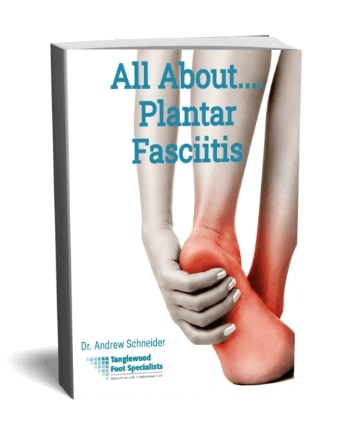Plantar fasciitis is one of the most common causes of foot pain that I see in my Houston podiatry office. The pain usually starts when you first step out of bed in the morning. Some people describe it like walking on broken glass. Others say there's a hot poker sticking into their heel. No matter how you describe it, it hurts!
How Plantar Fasciitis Develops
 The plantar fascia ligament attaches to your heel. The band of tissue extends through the bottom of your foot towards your toes. The plantar fascia ligament is important for the stability and support of your feet.
The plantar fascia ligament attaches to your heel. The band of tissue extends through the bottom of your foot towards your toes. The plantar fascia ligament is important for the stability and support of your feet.
As you walk, the plantar fascia flexes to act as a shock absorber. That means that every step you take, the plantar fascia ligament pulls on your heel. This repetitive pulling is what causes plantar fasciitis. The plantar fascia becomes inflamed where it attaches to the heel bone. This leads to the heel pain associated with plantar fasciitis.
Symptoms of Plantar Fasciitis
Plantar fasciitis is the most common cause of heel pain. This is due to the plantar fascia ligament pulling on your heel every step you take. You may feel intense heel pain with your first steps out of bed in the morning. This common symptom often decreases as you walk. It can come back again after you've sat for a period of time or at the end of the day. If plantar fasciitis gets bad enough the pain may not go away throughout the entire day.
Plantar fasciitis does not only have to affect your heel. The ligament extends through the entire sole of your foot. Sometimes it causes arch pain only. Or it may cause both heel and arch pain. In fact, there are many ways for pain from plantar fasciitis to present. Heel pain caused by plantar fasciitis is the most common presentation.
How Plantar Fasciitis is Diagnosed
When you come into my Houston podiatry office with suspected plantar fasciitis, I'll perform a comprehensive physical exam. I'll take an x-ray. I do this for a couple of reasons. First, there are other causes of heel pain that we have to make sure you don't have. For instance, if you have a hairline fracture in your heel, it is very important that it is found. The treatment for a stress fracture of the heel bone is treated much differently. I also take an x-ray to check to see if a heel spur has developed.
In addition to an x-ray, I may use a diagnostic ultrasound to look at the plantar fascia ligament itself. When the ligament is inflamed, I'm able to see it thickening on the ultrasound. The ultrasound is also useful if I have to give you an injection. It allows me to place the medication exactly where the inflammation is.
In cases where your heel pain does not resolve as expected with treatment, I may order an MRI. This gives a more detailed image of the bone and soft tissue. It allows me to see if there is anything other than plantar fasciitis causing your pain. It will also detect damage to the ligament, known as plantar fasciosis. Most cases of heel pain do not need an MRI.
Are Plantar Fasciitis and Heels Spurs the Same?
 Plantar fasciitis and heel spurs are associated, but they are not the same. In fact, some refer to plantar fasciitis as Heel Spur Syndrome.
Plantar fasciitis and heel spurs are associated, but they are not the same. In fact, some refer to plantar fasciitis as Heel Spur Syndrome.
A heel spur is a bone spur that forms on the bottom of the heel bone. It forms because of the tension of the plantar fascia ligament as it pulls on your heel bone. The bone spur forms in response to that tension. It is a symptom of overuse of the plantar fascia. Not every case of plantar fasciitis has a heel spur.
If a heel spur is present on x-ray, it gives me valuable information about the mechanics of your feet. The heel spur is rarely the source of pain. Because you have a heel spur does not mean that it has to be removed surgically. In fact, less than 5% of heel spurs needs foot surgery to treat them.
Plantar Fasciitis Treatment
Stretching
 Stretching is an important nonsurgical treatment to helping to resolve plantar fasciitis. There are two stretches that are helpful. First, rolling a ball, rolling pin, or frozen water bottle through the arch of the foot. This mobilizes the tight plantar fascia. Stretch out your foot before you get out of bed in the morning. You may be able to calm down the pain you feel when you first get up.
Stretching is an important nonsurgical treatment to helping to resolve plantar fasciitis. There are two stretches that are helpful. First, rolling a ball, rolling pin, or frozen water bottle through the arch of the foot. This mobilizes the tight plantar fascia. Stretch out your foot before you get out of bed in the morning. You may be able to calm down the pain you feel when you first get up.
The other important stretch is a stretching your calf muscles. This will stretch your Achilles tendon. It also helps to stretch your plantar fascia. You can stretch against a wall. You also can use a towel to pull back your foot when you're sitting. Hold each stretch for a slow ten count.
Anti-Inflammatory medication
The pain from plantar fasciitis is due to the inflammation of the ligament. It makes sense that anti-inflammatory medication is a useful treatment to treat the inflammation. As the inflammation reduces, so does the pain.
I use anti-inflammatory medication in one of two ways. I can locally pinpoint the inflammation. It makes sense to use a treatment that also works at the point of inflammation. A corticosteroid injection is the preferred way to deliver the medication. A steroid injection allows the medicine to be dropped right at the point of inflammation. An injection may not be the best treatment for you. In that case, a course of oral anti-inflammatory medication will be used.
Medical-Grade Insoles
Anti-inflammatories will manage the inflammation. You also need something to manage the cause of the inflammation. This is the mechanical pull of the plantar fascia ligament. It makes sense that you need to limit the pull of the plantar fascia. A medical-grade insole will support the ligament. This allows the anti-inflammatory to work better. I carry these medical-grade insoles in my Houston podiatry office.
Night Splints
 Plantar fasciitis often causes a sharp stabbing pain in the heel when you get out of bed in the morning. This is because your plantar fascia ligament contracts and shortens while you sleep. When you step out of bed, it is stretched and becomes inflamed again.
Plantar fasciitis often causes a sharp stabbing pain in the heel when you get out of bed in the morning. This is because your plantar fascia ligament contracts and shortens while you sleep. When you step out of bed, it is stretched and becomes inflamed again.
A night splint is a brace that you wear in bed. The splint keeps your foot in a flexed position while you sleep. This prevents the plantar ligament from shortening. You will likely feel reduced pain when you step out of bed after wearing night splint while you sleep.
Custom Orthotics
A custom orthotic is a specialized insole . It is made to provide support and efficiency to your foot and ankle. It is more than a shoe insert that provides arch support. A custom orthotic is designed to correct your foot mechanics. This treatment allows your foot to function in a more stable way. It will also prevent the overuse of your plantar fascia ligament. This will allow the inflammation causing your foot pain to decrease. It will also prevent its return.
Not all custom orthotics are created equal. In my Houston podiatry office, I perform a complete biomechanical examination. I also watch you walk so I can do a proper gait analysis. These elements are crucial to make the perfect custom orthotic for you. I then take a mold of your feet while maintaining them in the most stable position. If your custom orthotics weren't made this way, it's time for you to come in for an update.
Regenerative Medicine
Regenerative medicine is one of the newer treatments for soft tissue inflammation. It is very successful to treat plantar fasciitis. These include platelet rich plasma (PRP) injections and Extracorporeal Shockwave Therapy
These therapies help to reduce inflammation. PRP also contain growth factors to help to repair the damaged tissue. I find that using these injections, along with shockwave therapy, helps you to make a more complete and lasting recovery.
Tenex and Tenjet Procedure
The Tenex or Tenjet procedure are minimally invasive procedures done in the operating room. I use diagnostic ultrasound to image the inflamed plantar fascia ligament. A very small incision is made and a probe is inserted into the damaged ligament. The tip of the probe vibrates rapidly using ultrasonic energy. This breaks up the inflamed tissue. The broken up tissue is removed with suction.
This treatment is performed under anesthesia but there is little down time afterwards. You don't even need to wear a special surgical shoe after. You're able to walk immediately after the procedure. You'll see the full results of these procedures within six weeks.
Fat Injections: The Next Frontier?
Right now, everyone's talking about how injecting belly fat into the soles of your feet could combat plantar fasciitis. That's because a small study in the Journal of Plastic and Reconstructive Surgery could help prevent surgery for patients with severe pain. Now, this study interests me for a few reasons. First, it seems to work because fat cells have regenerative powers. (And, as I already mentioned, I already treat heel pain with regenerative medicine. I just don't use your fat cells...at least, not yet.)
I also know that fat cushioning can address pain effectively for other foot problems. That's why I use a product called Leneva to restore the fat pads on your forefoot. And I've seen great results using that treatment method. So, I'm eagerly watching developments on fat injections for heel pain. But, for now, even the study authors agree we need larger clinical trials before this becomes a widespread treatment option for heel pain.
Will Plantar Fasciitis Come Back?

It is a relief when your pain goes away with treatment for plantar fasciitis. But the job is only half done. The inflammation has reduced and the pain followed suit. Unfortunately, the mechanics that caused your heel pain to form is still the same. Those mechanics must be addressed so the painful condition doesn't return.
Your plantar fascia pain may have gone away quickly by using medical-grade insoles. In that case, keep wearing them. Those insoles will provide support for the plantar fascia ligament. That will help to limit the pull of the ligament.
It may have taken a long time to treat your foot pain. You likely need more mechanical control than medical-grade insoles provide. In these cases, I'd suggest the use of a custom orthotic. A custom orthotic is the best long-term treatment for plantar fasciitis. It is the best way to prevent plantar fasciitis from coming back.
Evaluating you for a custom orthotic is more involved than you'd think. I do a comprehensive biomechanical examination with a gait analysis. This lets me know how your foot is functioning when you're walking. I then take a mold of your foot in a stable, neutral position. I create a prescription to make the custom orthotic. This will make your feet as stable and efficient as possible.
When Plantar Fasciitis Won’t Go Away
You may reach a point when all conservative measures have been exhausted. It is then time to consider surgical options to treat plantar fasciitis . Like any surgical treatment, it should be a last resort. Surgery involves a plantar fascia release from the heel bone. If you have a heel spur, I will remove that as well.
In most cases, you will be able to walk in a surgical shoe after your surgery. You can return to full activity 8 to 12 weeks after surgery. After surgery for plantar fasciitis, it is crucial that you use a custom orthotic. This is because your plantar fascia is released and no longer has function. An orthotic will provide the support and stability to your foot.
Who Treats Plantar Fasciitis?
Plantar fasciitis is one of the most common causes of foot pain that I see in my Houston podiatry office. I have on-site digital x-ray and diagnostic ultrasound, so we can get to the bottom of what's causing your pain. The best time to treat heel pain is now. Come into the office for treatment soon. The quicker you can get back to your activities and exercise that you love. Contact Houston podiatrist Dr. Andrew Schneider for an immediate appointment






















